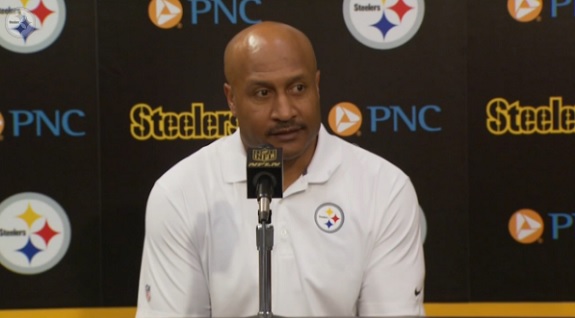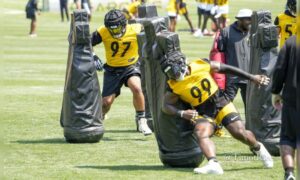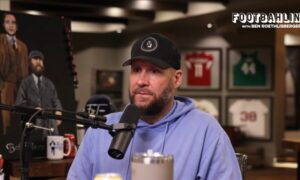Whenever a team has a weakness in one particular area of its personnel, it is the gut reaction to immediately put the position coach under fire. Often, perhaps too often, we see that position coach take the fall when a deeper analysis might show that he wasn’t the problem.
The Patriots recently dumped their offensive line coach after a rather poor showing against the Broncos with a beat up line. The Chargers, who have had a string of both bad luck and underachieving talent, were quick to add him to their staff. Time will tell what success the future holds for him.
When it comes to the Pittsburgh Steelers, many would see defensive backs coach Carnell Lake be the sacrificial lamb given the state of the secondary, particularly over the course of the past two seasons, even if the team finished first in the league in terms of yards allowed in each of his first two years with the team.
During the regular season, the Steelers gave up 271.9 yards through the air per game, the third-most in the league. Their 7.5 yards per attempt was a more respectable figure that fell somewhere in the middle of the pack, while their 29 receiving touchdowns allowed ranked 14th, and their pass attempts per touchdown allowed ranked 15th. To compensate, the team ranked tied for sixth in interceptions, which was ninth in terms of attempts per interception.
And they did all of this with William Gay as their clear, unquestioned top cornerback, alongside an injured Antwon Blake, with Ross Cockrell and, later, Brandon Boykin mixed in, to go along with a clearly liable tackler in Will Allen starting next to an admittedly improved Mike Mitchell.
There were a few people who drew comparisons between Lake and how some of the other team’s position coaches have performed recently, such as Mike Munchak, John Mitchell, and Richard Mann. The wide receivers group is among the best in the league, while the offensive line is on its way, and the defensive line is becoming the central focus of that side of the ball.
But the difference between their position groups and what Lake has dealt with over his tenure, for the most part, is a disparity in pure talent, which, as the article yesterday noted, is a byproduct of both priority as well as errors in evaluation.
Whereas the defensive line has transitioned away from its former stalwarts, those players have been replenished with first- and second-round talent in the form of Cameron Heyward and Stephon Tuitt, respectively, while Steve McLendon has been a presence for six seasons now.
Munchak has had a tumultuous second season in terms of injury, but it cannot be ignored that the Steelers invested heavily in the offensive line from 2010 to 2012, featuring four draft picks in the top two rounds of those drafts, one of which was an All-Pro last year, and another an All-Pro this year.
Mann happens to have the luxury of coaching Antonio Brown, while the Steelers have been consistent in replenishing the talent pool, chiefly with third-round pickups, which seems to have become a niche area for them, spiced with a key free agent from time to time as a veteran presence.
Running backs coach James Saxon? Not only has he had Le’Veon Bell, a second-round draft pick and an All-Pro, two of the Steelers’ three biggest free agency acquisitions over the past two offseasons have come at the position, with DeAngelo Williams this year proving hugely valuable. It’s also worth noting that the improvements from the offensive line and backfield have complementary positive influences on one another.
The Steelers, meanwhile, have not invested highly in the secondary outside of Mitchell, who was one of the team’s best players this season, or have yet to see them on the field—namely 2015 second-round draft pick Senquez Golson.
Prior to this most recent draft, the Steelers had not taken a cornerback in the first four rounds since Lake’s first season in 2010, drafting Curtis Brown and Cortez Allen in back-to-back rounds. The former was an outright bust from a defensive standpoint, while the latter showed just enough to earn a contract that is helping to hamstring the secondary’s progress forward.
The bottom line here is that Lake cannot possibly share sole responsibility for the failings of the secondary when he is given little to work with. If you want to make the argument that he has failed to develop the talent that was given to him, I ask you to find a talent that the Steelers have let go from the secondary that has found any type of meaningful success elsewhere. The closest you’ll find is Crezdon Butler, and that’s not saying much.
My concern with Lake is whether or not his scouting input is a detriment to the process, given his apparent influence in the selection of Shaquille Richardson in 2014, having recruited at UCLA, and previously, his possible ties in the Steelers trading a third-round pick to draft Shamarko Thomas, of whom he gave one of the more glowing post-draft evaluations of a selection that I can recall hearing.
I do not think that there is anywhere near enough a significant amount of evidence to suggest that Lake cannot coach a secondary. Considering that Gay has played the best football of his career under him and that Cockrell was able to jump in and play two weeks after joining the team, he must have some coaching talent. Keenan Lewis also credited Lake with helping him turn his career around.
Is there a potential issue pertaining to his scouting eye, at least when it comes to identifying players that can transition from college to the pros? There may be reason to believe that. But the talent evaluation at the position, and the value of the position overall, goes much deeper than that, and is the key issue that is truly at the root of the problem.








